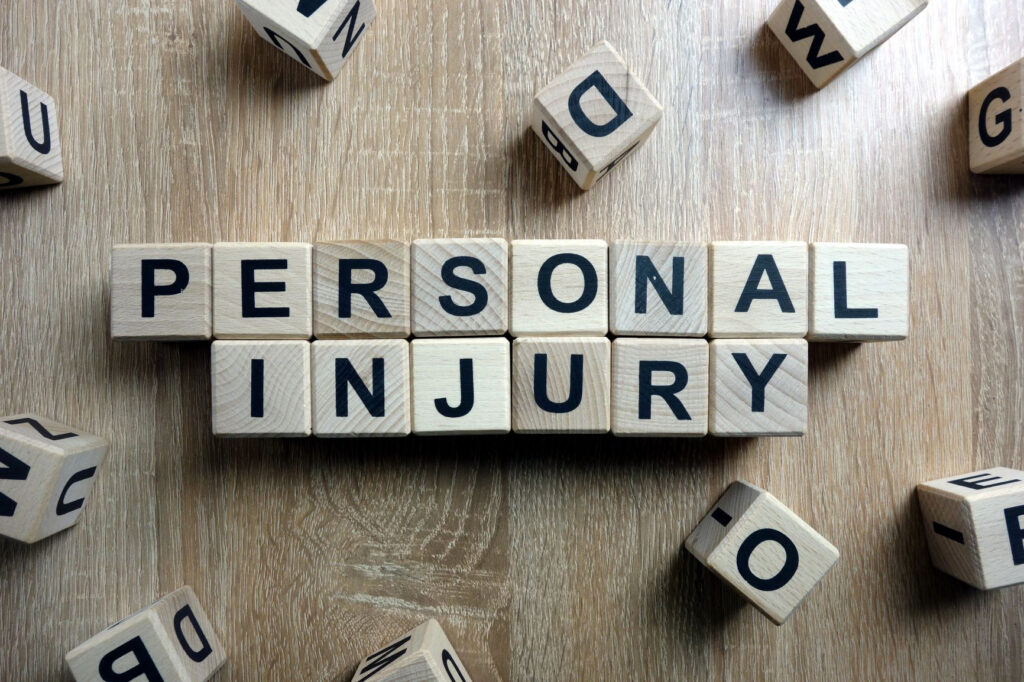What is a Personal Injury?
Personal injury law, also called ” tort” law, is designed to compensate people who’ve been harmed because of other people’s actions. Examples of typical personal injury claims include:
Car Accidents: Injuries sustained from car accidents, regardless of who is at fault, may be eligible for a personal injury claim. These claims are often based on negligence or recklessness and can include medical expenses, lost wages due to the inability to work, property damage, pain and suffering.
Slip and Fall Accidents: Property owners have a responsibility to keep their premises safe and free of any hazardous conditions. If the owner fails to meet this responsibility, they may be held liable for any injuries that result from a slip and fall accident on their property.
Medical Malpractice: When a medical professional fails to provide a reasonable level of care and that failure results in injury or death, the patient may be able to file a claim of medical malpractice against them.
Dog Bites: Some states have a “strict liability” law for dog bites, which means that a pet owner is liable for any damage caused by their animal regardless of whether or not they had any knowledge of the animal’s aggressive nature. Other states may require proof that the owner was aware of the danger and failed to take proper action to prevent it from occurring. In either case, victims of a dog bite may be able to file a personal injury claim for damages.
Product Liability: Manufacturers are legally responsible for any harm that their products cause. If an injury is caused by a defective product or one that was not properly labeled, consumers may be able to file a lawsuit against the manufacturer.
Wrongful Death: When someone passes away due to the negligence or recklessness of another person, their family may be able to file a wrongful death lawsuit against them. This type of claim allows family members to receive compensation for medical costs, funeral expenses, lost wages and other damages.
No matter what kind of personal injury you are experiencing, it is important to contact an experienced attorney as soon as possible in order to ensure that your rights are protected. An attorney can evaluate your case and help you determine the best course of action.

Types of Personal Injury Damages and Types of Compensation
Personal injury claims are civil lawsuits that allow individuals to seek financial compensation for physical, psychological, or emotional harm caused by the negligence of another party. When filing a personal injury claim, it is important to understand the different types of damages and compensation available.
The most common type of personal injury damages are compensatory damages. These damages are meant to compensate an injured individual for the financial and emotional losses associated with their injury.
Compensatory damages may include medical expenses, lost wages, pain and suffering, property damage, loss of consortium (the right of one’s spouse to receive love, comfort, and companionship), mental anguish, and any other out-of-pocket expenses related to the injury.
Two Types of Damages
In general, there are two types of damages in personal injury cases; these are known as economic and non-economic damages.
Economic Damages
In a personal injury cases economic damages will include the costs of medical treatment, future medical care if required, lost wages due to missed work, and property damage.
Non-Economic Damages
In a personal injury case may include compensation for physical pain and suffering, mental anguish, loss of enjoyment of life, emotional distress, and other non-monetary losses.
Wrongful Death Damages
Wrongful death damages are a type of personal injury compensation that are intended to provide financial and emotional support for the surviving family members of someone who has died as a result of another party’s negligence or misconduct.
These damages can help cover medical bills, funeral expenses, and loss of income due to the untimely death. Wrongful death damages also include compensation for non-financial losses, such as pain and suffering, loss of companionship or loss of consortium, loss of parental guidance, and mental anguish.
Strict Liability Claims
Strict liability claims are based on the idea that a defendant should be held liable for their actions, regardless of intent. This type of claim applies in cases involving hazardous products or activities. For example, if you have been injured by a defective product, you may be able to pursue a strict liability claim against the manufacturer.
Negligence Claims
Negligence claims involve situations in which a defendant has acted carelessly or failed to use reasonable care in order to protect another person from harm. Negligence claims can be based on intentional or unintentional conduct.
Examples of negligence claims include medical malpractice, slip and fall cases, and car accidents.

Limitations on Injury Compensation
When filing a personal injury claim, it is important to be aware of the limitations that may apply. These limitations can vary based on the jurisdiction in which you are filing and the type of claim that you are making. Examples of such limitations include:
Statute of Limitations: Most jurisdictions impose a statute of limitations on personal injury claims, which sets a deadline for filing a claim.
Caps on Damages: Laws in some states may limit the amount of damages that an individual can receive, even if they win their case. These caps are typically applied to punitive damages awards and may vary depending on the circumstances of the case.
Resolution of Personal Injury Claims
The resolution of a personal injury claim depends on the details of the case and the laws governing it. Depending on the circumstances, personal injury claims can be resolved through negotiations between lawyers and insurance companies, or through a trial. Negotiations may involve settlement offers from one party to another, while trials involve presentations and arguments in court.
In some cases, an out-of-court settlement may be negotiated to avoid the cost and time associated with a trial. However, if negotiations fail or the settlement offer is deemed inadequate, the case may proceed to trial.
Alternative Dispute Resolution
In some cases, parties may opt for an alternative dispute resolution (ADR) process instead of seeking a trial. ADR processes allow parties to resolve disputes through methods such as arbitration, mediation, or negotiation. These methods can be less costly and time-consuming than a trial and may result in a mutually satisfactory outcome.
Insurance Claims
Although many personal injury claims are filed against individuals, some may be filed against insurance companies. Insurance policies typically provide coverage for certain types of damages due to an accident or incident. In these cases, the injured party must file a claim with the relevant insurance company to seek compensation from them.
When filing a claim with an insurance company, it is important to understand the terms and conditions of the policy and provide sufficient evidence to support the claim. Insurance companies may deny claims that they deem to be without merit, so it is important to ensure that you have the necessary evidence to back up your claim.
Tort Reform Limits on Injury Compensation
Tort Reform Limits on Injury Compensation: Tort reform is a set of laws that limit the amount of damages that an individual can receive in certain types of cases. These limits are typically applied to punitive damages awards and may vary depending on the circumstances of the case.
Tort reforms have been enacted in many states to help curb frivolous lawsuits, reduce insurance costs, and promote faster resolution of disputes. The specifics of these laws will depend on the jurisdiction in which you are filing your claim.
Insurance Policy Limits
Insurance Policy Limits: Insurance policies typically contain limits on the amount of money that can be paid out in claims. These limits may apply to the total amount of coverage, the type of coverage offered, or the number of incidents that are covered by a policy. It is important to understand the terms and conditions of an insurance policy before filing a claim in order to ensure that you will receive appropriate compensation.
Personal Injury Claims vs. Personal Injury Lawsuits
Understanding the difference between a personal injury claim and a personal injury lawsuit is important in determining the best course of action for recovering damages in an accident or incident. While both involve seeking compensation for losses suffered due to another party’s negligence, there are significant differences between them.
A personal injury claim is typically filed with an insurance company and involves negotiations between the parties to reach an agreement on compensation. On the other hand, a personal injury lawsuit is filed in court and requires a trial if the parties are unable to reach a settlement agreement through negotiations.
 Personal Injury Claim
Personal Injury Claim
A personal injury claim is typically filed with an insurance company and involves negotiations between the parties to reach an agreement on compensation. In these cases, the injured party must file a claim with the relevant insurance company to seek compensation from them.
When filing a claim, it is important to understand the terms and conditions of the policy and provide sufficient evidence to support the claim. Additionally, tort reform limits may apply to punitive damages awards in some cases.
Personal Injury Lawsuits
A personal injury lawsuit is filed in court and requires a trial if the parties are unable to reach a settlement agreement through negotiations. In a personal injury lawsuit, the injured party must establish that another party was negligent in causing the accident or incident that resulted in their injuries.
This typically involves providing evidence of negligence and demonstrating how that negligence was the proximate cause of the accident or incident. Additionally, damages awards are based on a variety of factors, including lost wages and medical expenses.
What is The Average Compensation in a Personal Injury Claim?
The average compensation amount for a personal injury claim will vary depending on the nature and severity of the injuries sustained. Generally, the more serious the injuries, the higher the compensation amount. Other factors such as lost wages and medical expenses can also influence how much an injured party can expect to receive in compensation.
Generally, a personal injury claim can result in a compensation award of several thousand dollars to tens or even hundreds of thousands of dollars.
Negligence and Liability
In order to seek compensation for a personal injury, the injured party must typically prove that another party was negligent in causing the accident and injuries sustained.
Negligence is the legal term used to describe a breach of duty of care by another person or entity. If it can be proven that one party acted negligently and caused an injury, they may be found liable for any resulting damages.
Duty of Care
Duty of Care is a legal term used to describe an individual or entity’s responsibility to act in a reasonable manner in order to protect others from harm. This duty may vary depending on the circumstances and the relationship between the parties involved.
Generally, all individuals and entities must exercise reasonable care in order to avoid causing injury or damage to another person or property. If this duty is breached , they may be liable for any damages or injuries caused.
How to Collect Damages
There are two ways to collect damages in personal injury claims.
The first way to collect damages is through an insurance settlement. In this scenario, the injured party will negotiate with the insurance company to obtain compensation for their losses. This typically involves providing evidence of negligence and documenting any medical expenses or lost wages related to the injury.
If a settlement agreement is reached, the injured party can receive compensation without having to go to court.
The second way to collect damages is through a personal injury lawsuit. In this scenario, the injured party must file a lawsuit in court and prove that another party was negligent in causing the accident or incident that resulted in their injuries. If successful, they can receive damages for any medical expenses, lost wages, and other losses related to the injury.
Talk to an Experienced Personal Injury Lawyer Today!
Goldberg & Loren, our personal injury attorneys have been helping personal injury victims regardless of the type of injury for over 30 years. Our experienced attorneys understand the complexities of personal injury law and can help you receive the compensation you deserve.
If you or a loved one has sustained an injury due to another party’s negligence, we can help hold the responsible party accountable. Contact us today by calling 1-800-731-4878 to discuss your case. Get a free consultation, pay nothing unless we win. We are here to help!
References:
Tort Definition. (n.d.). www.nolo.com. https://www.nolo.com/dictionary/tort-term.html

